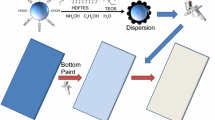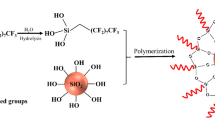Abstract
Using 3-aminopropyltriethoxysilane (KH550), γ-glycidyloxypropyltrimethoxysilane (KH560) and silica with different particle sizes as raw materials, the grafting reaction through layer-by-layer assembly strawberry-like silica particles with multi-scale effects were prepared, and their structures were characterized by infrared spectroscopy (FT-IR), hydrogen nuclear magnetic resonance (NMR), X-ray diffraction (XRD), transmission electron microscopy (TEM) and other testing methods. Then it was physically blended with laboratory-made water-based epoxy resin WEP, and the coating with superhydrophobic properties was prepared by the low surface energy modification of methyltrimethoxysilane (MTMS). Differential scanning calorimetry (DSC) and thermogravimetric analysis (TGA) to characterize the blending stability and heat resistance of the coating, and to analyze its morphological characteristics with scanning electron microscopy (SEM), and to analyze its abrasion resistance by measuring the change in the surface contact angle of the coating under certain conditions, Chemical resistance. The results showed that the prepared strawberry-like silica particles reached the expected structure, and formed Pickering emulsion similar to oil-in-water after blending with WEP, which was a stable emulsion system of solid particles. At the same time, due to the introduction of strawberry-like silica particles and the low surface energy modification of MTMS, the modified WEP has superhydrophobic properties, as well as excellent abrasion resistance, corrosion resistance and self-cleaning effect.















Similar content being viewed by others
References
He J, Zhao Y, Yuan M et al (2020) Fabrication of durable polytetrafluoroethylene superhydrophobic materials with recyclable and self-cleaning properties on various substrates. J Coat Technol Res 17:755–763
Shuai RA, Jc A, Miao JA et al (2020) The effect of drop volume on the apparent contact angle of hierarchical structured superhydrophobic surfaces-ScienceDirect. Colloids Surf, A 611:125849
Yang H, Wang S, Wang X et al (2020) Wood-based composite phase change materials with self-cleaning superhydrophobic surface for thermal energy storage. Appl Energy 261:114481
Li X, Liu H, Zhang Y et al (2022) Durable, self-cleaning and anti-fouling superhydrophobic coating based on double epoxy layer. Mater Res Express 9:026404
Guo Y, Zhang X, Wang X et al (2020) Wetting and tribological properties of superhydrophobic aluminum surfaces with different water adhesion. J Mater Sci 55:11658–11668
Wen H, Jia Y, Xiang B et al (2021) A facile preparation of the superhydrophobic polydimethylsiloxane materials and its performances based on the supercritical fluid foaming. Appl Polym Sci 138:e50858
Du C, He X, Tian F et al (2019) Preparation of Superhydrophobic Steel Surfaces with Chemical Stability and Corrosion. Coatings 9:398
Haixiao Kang, Baowei, et al (2019) Durable superhydrophobic glass wool@polydopamine@PDMS for highly efficient oil/water separation. J Colloid Interface Sci 544:257–265
Liu J, Yang L, Chen Q, Zhao Y, Xiao P (2021) One-step preparation of graphene oxide/silica nanoparticles superhydrophobic coating for enhanced anti-corrosion performance. Mater Lett 306:130869
Yu X, Liu X, Shi X et al (2019) SiO2 nanoparticle-based superhydrophobic spray and multi-functional surfaces by a facile and scalable method. Ceram Int 45:15741–15744
Qi Y, Yang Z, Huang W et al (2021) Robust superhydrophobic surface for anti-icing and cooling performance: Application of fluorine-modified TiO2 and fumed SiO2. Appl Surf Sci 538:148131
Liu X, Gu Y, Mi T et al (2021) Dip-Coating Approach to Fabricate Durable PDMS/STA/SiO2 Superhydrophobic Polyester Fabrics. Coatings 11:326
Jiang S, Zhou S, Du B et al (2021) Preparation of superhydrophobic paper with double-size silica particles modified by amino and epoxy groups. AIP Adv 11:025127
Nguyen HH, Tieu AK, Tran BH et al (2020) Porosity-induced mechanically robust superhydrophobicity by the sintering and silanization of hydrophilic porous diatomaceous earth. J Colloid Interface Sci 589:242–251
Gao H, Jian Y, Yan Y (2021) The effects of bio-inspired micro/nano scale structures on anti-icing properties. Soft Matter 17(3):447–466
Taskin NU, Ordu F (2020) Effect of etching duration on roughness and wettability of different carbon steel substrates. Mater Chem Phys 257:123746
Ansari A, Nouri NM, Sekhavat S et al (2020) A large-scale approach for superhydrophobic coating fabrication. Proc Inst Mech Eng, Part B 235(6–7):1109–1119
Ghosh S, Das P, Ganguly S et al (2019) 3D-Enhanced, High-Performing, Super-hydrophobic and Electromagnetic-Interference Shielding Fabrics Based on Silver Paint and Their Use in Antibacterial Applications. ChemistrySelect 4(40):11748–11754
He J, Zhang Y, Wang J et al (2020) Eco-friendly, magnetic-driven, superhydrophobic sponge for oil/water separation and emulsion purification. J Mater Sci 55(15):6708–6720
Ren S, Chen Y, Xu K et al (2020) Maintenance of superhydrophobic concrete for high compressive strength. J Mater Sci 56(7):4588–4598
Kwok DY, Neumann AW (1999) Contact angle measurement and contact angle interpretation. Adv Colloid Interface Sci. 81(3):167–249
Xu R, Wang H, Sun R, Lei S (2012) Preparation and FTIR Analysis of Modified Nano-Silica. Guangdong Huagong 39(16):3–4
Li J, Jiang L, Zhao X, Xu Y, Gao L, Shu M (2021) Analysis of α-state crystalline silica content in spherical silica powder by X-ray diffraction method. Guangdong Huagong 48(19):26–27
Chang Z, Lu Y (2022) Fabrication of superhydrophobic surfaces with Cassie-Baxter state. J Dispersion Sci Technol 43(8):1–10
Xu B, Zhao Z, Xu G, Yang J, Liang Y, Hu J (2018) Preparation of superhydrophobic and superoleophilic glass fiber filter membrane and its emulsification water separation efficiency. Guisuanyan Xuebao 46(8):1173–1177
Feng P, Wang X, Yang J (2022) Biomimetic, Highly Reusable and Hydrophobic Graphene/Polyvinyl Alcohol/Cellulose Nanofiber Aerogels as Oil-Removing Absorbents. Polymers 14(6):1077
Feng P, Wang X, Yang J (2022) Highly compressible and hydrophobic anisotropic cellulose-based aerogel fabricated by bidirectional freeze-drying for selective oil absorption. J Mater Sci 57(27):13097–13108
Acknowledgements
This project is financially supported by the Guangdong Provincial Department of Natural Resources Guangdong Marine Economic Development (Six Marine Industries) Special Funds Project (Guangdong Natural Resources 2021-33).
Author information
Authors and Affiliations
Corresponding author
Ethics declarations
Conflict of interest
The authors declare that they have no known competing financial interests or personal relationships that could have appeared to influence the work reported in this paper.
Additional information
Publisher's Note
Springer Nature remains neutral with regard to jurisdictional claims in published maps and institutional affiliations.
Rights and permissions
Springer Nature or its licensor (e.g. a society or other partner) holds exclusive rights to this article under a publishing agreement with the author(s) or other rightsholder(s); author self-archiving of the accepted manuscript version of this article is solely governed by the terms of such publishing agreement and applicable law.
About this article
Cite this article
Su, H., Yang, J. Design and preparation of multiple silica particles and study on superhydrophobic modified epoxy resin. J Polym Res 30, 238 (2023). https://doi.org/10.1007/s10965-023-03617-6
Received:
Accepted:
Published:
DOI: https://doi.org/10.1007/s10965-023-03617-6




